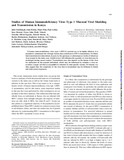Studies of human immunodeficiency virus type 1 mucosal viral shedding and transmission in Kenya.
Date
1999-05Author
Overbaugh, J
Kreiss, J
Poss, M
Lewis, P
Mostad, S
John, G
Nduati, RW
Mbori-Ngacha, DA
Martin, H Jr
Richardson, B
Jackson, S
Neilson, J
Long, EM
Panteleeff, D
Welch, M
Rakwar, J
Jackson, D
Chohan, B
Lavreys, L
Mandaliya, K
Ndinya-Achola, JO
Bwayo, JJ
Type
ArticleLanguage
enMetadata
Show full item recordAbstract
If human immunodeficiency virus type 1 (HIV-1) vaccines are to be highly effective, it is essential to understand the virologic factors that contribute to HIV-1 transmission. It is likely that transmission is determined, in part, by the genotype or phenotype (or both) of infectious virus present in the index case, which in turn will influence the quantity of virus that may be exchanged during sexual contact. Transmission may also depend on the fitness of the virus for replication in the exposed individual, which may be influenced by whether a virus encounters a target cell that is susceptible to infection by that specific variant. Of interest, our data suggest that the complexity of the virus that is transmitted may be different in female and male sexual exposures.
URI
http://www.ncbi.nlm.nih.gov/pubmed/10099106http://erepository.uonbi.ac.ke:8080/xmlui/handle/123456789/30319
Citation
J Infect Dis. 1999 May;179 Suppl 3:S401-4Publisher
University of Nairobi. Department of Paediatrics and Child Health, Univeristy of Nairobi, Kenya
Collections
- Faculty of Health Sciences (FHS) [10378]

